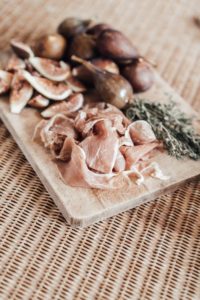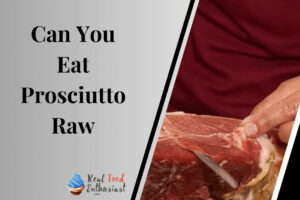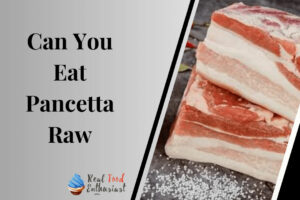Have you ever eaten any meat in its raw form? Can you eat prosciutto raw? Here are some interesting details about prosciutto. Some parts of it may be are known to you but I can assure you that, you have not heard many parts about it. If you are excited to find out then, keep reading!
Can you eat prosciutto raw?
This loved Italian meat is salty having a pink color. These finely cut thin slices of salumi are something that you cannot resist eating. Prosciutto is the Italian term for ham. There are basically two types of prosciuttos. Crudo which is the raw, dried and salt-cured delicacy and then there is the Cotto which happens to be like the regular cooked ham. In fact, the origins of prosciutto Crudo happen to go back to the pre-Roman era. In Italian villages, pork legs were dry-age,that would last the long winters. This century-old art is in practice not only in Italy but all across the world.

Prosciutto is made from pork legs having high-quality meat. After covering the meat in salt, it is kept to rest for a few weeks. During this time what happens is, salt extracts out the blood and moisture that are trapped in the meat. This prevents the bacteria from getting into the meat. This is the reason why it is absolutely safe to eat rawprosciutto. Salting the meat also serves another purpose.
It makes the flavor more concentrated. Once the process of salting is done, these pork legs are then seasoned by hand. This seasoning can either be following any traditional methods, recipes from culinary books or can also be the family’s own recipe.
Thereafter, the pork legs are left to dry-age at a temperature that is monitored. It stays for 14 -36 months. All this while, the combination of salt, air and duration of time on its own creates a delicate and sweet flavor for the prosciutto. It is interesting to note that, the techniques to produce prosciutto differs based on regions, consortium and the individual. Here is all about can you eat prosciutto raw.
Prosciutto is very flavorful. It is delicate, sweet yet has an element of saltiness to it too. Its color varies from salmon pink to brownish-red and each of its slices carries streak of fat. In fact, there are even some varieties of prosciutto which are seasoned with different herbs and spices. The thing to notice is that the longer it shall age the more complex it shall taste too. The process of curing changes the entire flavor and the texture of the meat.It must be remembered that prosciutto is the most delicate form of pork meat preparation so, they must never be overcooked or be exposed to high heat while cooking.
Prosciutto is usually cut into very thin slices. As thin as the paper. In order to relish its complete flavor profile, let the thin slices melt in your tongue allowing the delicate, creamy, sweet and salty flavor to grab your senses and the palate. They also make a good pair with fruits, vegetables, cheese, bread, wine and are added to various dishes too.
One of the best characteristic features of prosciutto is that it is absolutely free from any sort of additives or preservatives. The meat contains vitamins B1, B2, vitamin E, proteins, unsaturated fats, minerals such as sodium, iron, potassium and phosphorous. In addition to that, there are no phosphates, nitrites, gluten, nitrates or lactose.

Fascinating facts
- The word ‘ham’ is from Old English ham or home which means the knee’s hollow bend and the Germanic base meaning crooked. It came into use to mean the leg of an animal in the 15th century.
- Around the world, people mostly choose ham when it comes to pork meat.
- Cato the Elder has mentioned about “salting of hams” in De Agri Cultura tome in 160 BC.
- Some say that the Chinese were the first to mention about cured ham back in 4900 B.C. China.
- Larousse Gastronomique says that its origin is from Gaul, being established strongly during the Roman period. There is evidence from import trade from Gaul as written by Marcus Terentius Varro.
The research findings clearly state that eating prosciutto raw is a delicious form of consuming meat.
Here is all about can you eat prosciutto raw.





